With all due respect to culture and history people, there’s simply nothing in this world like exploring the nature, especially the beautiful mountains. China, with a great variety of topography and awe-inspiring natural beauty, is home to some of the most magnificent mountains in the world.
From dramatic UNESCO-listed karst peaks in the South China to mystical mountain ranges of the Himalayas, these China mountains offer life-time travel experiences to explore the breathtaking wonders of nature. So if you are exactly mountain people who plan to travel to China, don’t miss the top 10 most beautiful mountains in China, each with unique landscape and charm.
1. Mount Everest – World’s Highest Peak and Still Growing
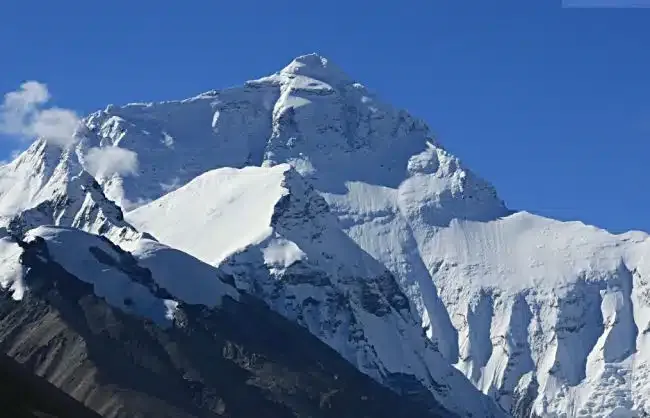
Height and Location
At the top of our list of the most beautiful mountains in China China stands the legendary Mount Everest, the highest peak in the world. Located on the border between China and Nepal, Mt. Everest reaches a staggering height of 8,848 meters (29,029 feet) above sea level. What’s more surprisingly, until today, the Himalayas are still in a constant state of ascension, rising by 7 centimetres every 100 years
Natural Wonder and Breathtaking Mountain Vista
About 65 million years ago, the Indian subcontinent rushed towards and eventually crashed into Asia and Europe, forming the long stretch of the Himalayas. Therefore, Mount Everest has a unique natural landscape, including rivers, lakes, glaciers, ice margins, wind and sand, and many other landform types and their complex modern surface patterns. There are also numerous geohistorical relics, such as the three-toed horse fossil group in the Pliocene of NeruXiongLa in Gyirong County, and the alpine scintillator fossil group in Shishapangma Peak, which are of great scientific and aesthetic value.
Cultural and Historical Significance
Beyond its natural splendor, Mount Everest is a sacred mountain for local Tibetans. Tibetan Buddhists consider it a remarkable achievement and a spiritual journey to climb the peak Mt. Everest.
At 4,900 metres above sea level on Mount Everest sits the world’s highest monastery, Rongbuk Monastery, which was founded in 1899 by the Red Lama Ngawang Tenzin Lobo. It is the end of the Tibet tours for the average tourist and the last civilisation before Everest Base Camp. Jomolang Monastery is also the best location to view Mount Everest; both are 25 kilometres away in a straight line..
Recommended Tour: 8 Days Lhasa to Everest Base Tour
2. Mount Huangshan – A Beautiful Mountain All Year Round
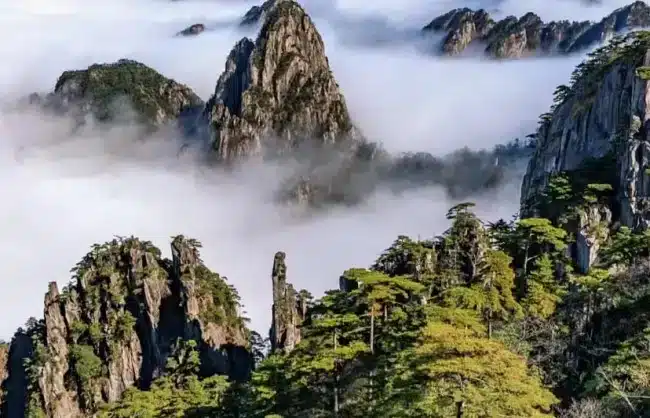
Majestic Peaks and Unique Granite Formations
Mount Huangshan, also known as the Yellow Mountain, experienced orogenic movement and crustal uplift, as well as glaciation and natural weathering, which ultimately formed its peak and forest structure. The body of Mount Huangshan is mainly composed of granite from the Yanshan period.
There are seventy-two peaks in Mount Huangshan, and the main peak, Lotus Peak, is as high as 1,864.8 metres above sea level, which is one of the three main peaks of Mount Huangshan together with Bright Peak and Tendu Peak. There are 77 other peaks over 1,000 metres in the surrounding area.
Grotesque Rocks, Ancient Trees and Hot Springs
One of the five wonders of of Mount Huangshan is its ancient pine trees, some of which are thousands of years old. There are top 10 famous pines of Mount Huangshan: Welcome Pine, Sending Pine, Pope Pine, Harp Pine, Unicorn Pine, Sea Scouting Pine, Receiving Pine, Lianli Pine, Black Tiger Pine, Dragon Claw Pine.
Additionally, Mount Huangshan is full of dangerous Granite stone forests abrupt cliffs and pillars, which are seen on the tops of the mountains, hillsides and valleys.
The natural hot springs of Yellow Mountian are another additional highlight for your Huangshan tours and provide a soothing retreat for weary hikers.
UNESCO World Natural and Cultural Heritage Site
Recognizing its exceptional natural beauty and cultural significance, Mount Huangshan was listed as a UNESCO World Heritage Site in 1990. Then, in February 2004, Mount Huangshan was also declared a World Geopark by UNESCO. Its unique blend of stunning mountain views and rich cultural heritage makes it one of the most beautiful mountains in China, as well as one of the popular destinations in China.
Recommended Tour: 4 Days Huangshan Classic Tour with Hongcun & Xidi Villages
3. Mount Kailash – the “Centre of the World” by the Four Great Buddhist Religions
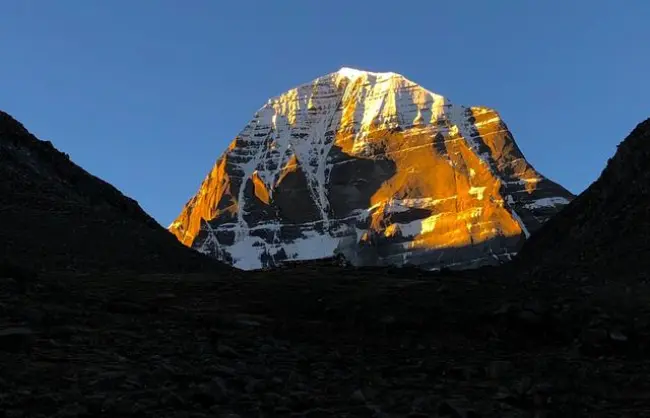
Sacred and Spiritual Significance the World’s Buddhist Culture
Located in the Ali region of western Tibet, Mount Kailash is the main peak of Mount Gangdisê, the Gangdisê mountain range. It is one of the four sacred mountains of Tibetan Buddhism, and is regarded as the “centre of the world” by Hinduism, Tibetan Buddhism, the native religion of Tibet, Benjaminism, and ancient Jainism.
Pilgrimages and Cultural Traditions
Mount Kailash is the dojo of Lord Buddha Shakyamuni, and is referred to as Mount Sumeru in Buddhism. For devout believers, Kora (circling around the mountain) can wash away their sins and give them a new lease of life. Therefore, every year at the beginning of summer, a large number of believers and travellers from India, Bhutan, Nepal and the major Tibetan areas of China come to the foot of the sacred mountain and start to Kora. The journey is about 53 kilometres, and it usually takes two days on foot.
Striking Snow-capped Mountain
Mount Kailash is 6,714 metres above sea level. Composed of Neoproterozoic conglomerate, it is a steep-walled, cone-shaped “pyramid-shaped” peak. Mount Kailash was selected as one of the ten most beautiful mountains in China by National Geographic China.
4. Mount Zhangjiajie – Avatar Hallelujah Mountian and More
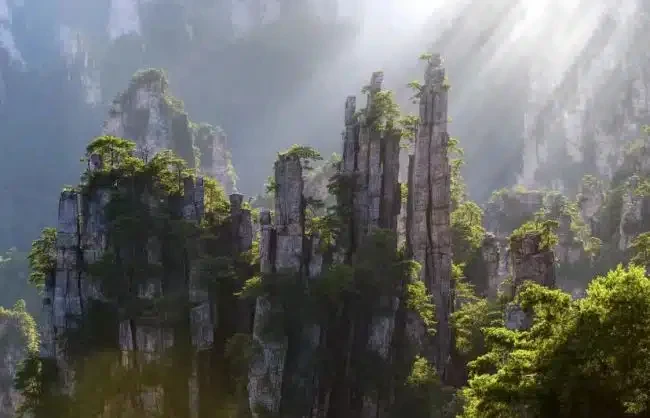
Otherworldly Sandstone Pillars
Another UNESCO natural heritage and Geopark in China, Zhangjiajie National Forest Park in the Wulingyuan Scenic Area is famous for its surreal sandstone pillars that rise surprisingly and majestically from the ground. These towering peaks, often shrouded in mist, was the inspiration for the floating mountains in the Hollywood blockbuster “Avatar.”
In addition to Zhangjiajie National Forest Park, the nearby Tianemen Mountain in Zhangjiajie is also very beautiful and offers a thrilling glass plank road.
Inspiration for “Avatar” Film
The ethereal beauty of the mountains in Zhangjiajie attracted international attention after its breathtaking scenery inspired the Hallelujah Mountain in the movie. Visitors from all over the world travel to Zhangjiajie and explore the enchanting forests, walk across the thrilling glass walkways, and immerse themselves in the magical atmosphere.
Glass Skywalk and Unique Attractions
To enhance visitors’ experience of the mountains, Zhangjiajie National Forest Park, Tianmen Mountain and Zhangjiajie Grand Canyon offers glass walkways to marvel at the incredible vistas from dizzying heights. The Bailong Elevator, at the ZJJ Forest Park, is a glass elevator built into the side of a cliff, and holds the Guinness World Record as the tallest outdoor elevator.
Recommended Tour: 4 Days Zhangjiajie Hiking Tour: Off-Beaten Route
5. Mount Hua – “the Most Dangerous Mountain under Heaven”
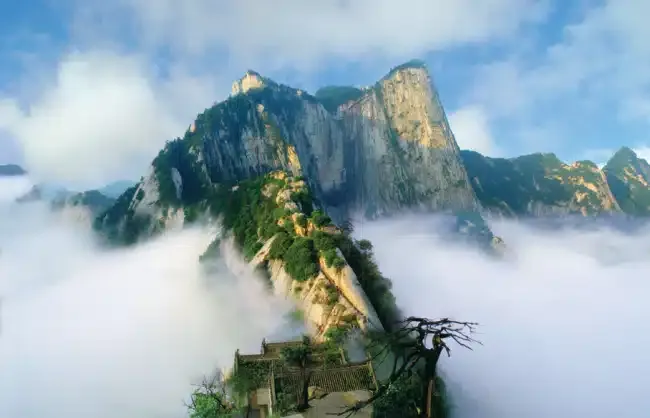
Thrilling Plank Walk and Cliffside Paths
Mount Hua, one of the Five Greatest Mountains of China, is located 120 kilometres east of Xi’an, and is often referred to as the “most dangerous mountain in the world”. If you’re an adventure seeker, the adrenaline-pumping attractions of Mount Hua is a big appeal. The North Peak is 1,614 metres above sea level and is overhanging on all sides. The South Peak is 2154.90 metres above sea level and is the highest main peak of Mount Hua. Climbing to the top of the South Peak and looking around, you can take in the views of North China, from the rolling hills, the Yellow River, the Weihe River, and the plains.
The Plank Walk is the most dangerous and thrilling way to the peaks. This narrow path secures trekkers to the cliffside with only chains and wooden planks, testing their courage and determination.
Ancient Taoist Temples
Amidst the thrilling trails, Mount Hua is the holy place of the Quanzhen School (全真教) of China Taoism and is known as the sacred “Fourth Cave”. There are 72 semi-suspended caves of Taoism and more than 20 Taoist temples, where many Taoist masters live in seclusion. These sacred sites, set in breathtaking views, are ideal places to learn Chinese Taoism and provide a serene retreat for spiritual life.
Spectacular Sunrise and Sunset
Take the cable car or trestle up Mount Hua for beautiful sunrises and sunsets. Standing on top of the mountain with friends or family, with cliffs at your feet, and watching the sun paint the sky in vibrant colours is an experience of a lifetime.
Recommended Tours:
6. Jade Dragon Snow Mountain – Accessible by Regular Tourists

Snow-Capped Peaks and Glaciers
Jade Dragon Snow Mountain in Lijiang, Yunnan Province, enchants with its snow-capped peaks, pristine glaciers, alpine glacial lake, and alpine meadows. The 13 peaks of Jade Dragon Snow Mountain are arranged vertically from south to north, with the highest point of the main peak, Fanziphe, at 5,596 metres above sea level. There are temperate oceanic glaciers that are the closest to the equator on the Asian and European continents. Its majestic beauty is heightened by the contrasting colors of the deep blue skies, and lush green valleys.
Naxi Ethnic Culture and Traditions
There are 12 villages around Jade Dragon Snow Mountain, with more than 10,000 people from seven ethnic groups, including Naxi, Han, Tibetan, Yi, Lisu, Bai and Pumi. Among them, Naxi is the most dominant ethnic group in the area.
Visitors can immerse themselves in the vibrant Naxi culture, and enjoy traditional Naxi music and dance performances, by watching the fantastic Impression of Lijiang show. The theatre is located in the Gan Haizi of Jade Dragon Snow Mountain Scenic Area. Being 3050 metres above sea level, it is the world’s highest live performance venue.
You can also explore nearby Naxi ancient towns that preserve the essence of this unique heritage.
A Heaven for Soft Outdoor Adventure
One of the most beautiful mountains in China, Jade Dragon Snow Mountain offers a plethora of exciting outdoor activities for adventure enthusiasts and adventurous families. Experience the mountain’s beauty and grandeur by hiking, horseback riding, or with cable car ride. The famous attractions include Blue Moon Valley, Spruce Meadow and Spruce Meadow.
Recommended Tour: 5 Days Yunnan Tour of Lijiang and Shangri-La
7. Mount Tai – “the Foremost of the Five Great Mountains in China”
Symbolising 5,000 years of Chinese civilisation history
One of the most important China mountains, Mount Tai is the spiritual home of the Chinese nation, the epitome of oriental culture, and the place where the idea of “unity of heaven and mankind” rests. It carries rich historical and cultural connotations, and was regarded by the ancients as a paradise that “leads directly to the throne”. The people worshipped Mount Tai, and the ancient emperors paid tribute to the God of Heaven on this mountain. Therefore, there is a saying that “if Taishan is at peace, the four seas are at peace”.
From the Qin Dynasty to the Qing Dynasty, there were 13 generations of emperors who personally boarded Mount Tai in order to seal or sacrifice. And another 24 generations of emperors sent officials to sacrifice 72 times.
Recommended Tour: One-Day Mount Tai Adventure Tour
Ancient Sites and Heavenly Stairs
There are 29 Buddhist and Taoist temples, 128 ancient ruins, and more than 2,000 small and large stone tablets and ancient cliff carvings on Mount Tai. Visitors are encouraged to climb the Heavenly Stairs, consisting of thousands of steps, to ascend the top of the mountain and watch the sunrise, an ancient ritual on Mount Tai.
Four Wonders on Mount Tai
The best time to visit Mount Tai is from May to November every year. There are four wonders to see: sunrise, sea of clouds, sunset, and the golden ribbon when the sun sets. In Addition,, don’t miss the 1000-year-old trees.
8. Mount Siguniang – Sichuan Giant Panda Habitat
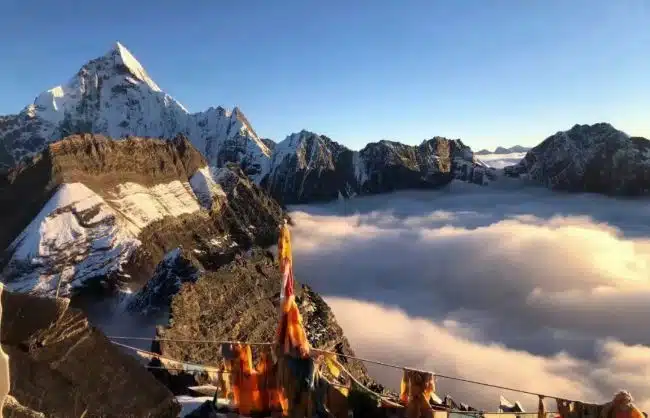
A UNESCO Site with Pristine Alpine Scenery
The Four Girls Mountains Scenic Area is a World Natural Heritage Site, a National Geopark and a habitat for giant pandas in Sichuan. The core attractions are Shuangqiaogou Valley, Changpinggou Valley, Haizigou Valley, the Oldest Sister Mountain and the Youngest Sister Mountain. There are 85 snow peaks above 5000 metres in altitude, and modern mountain glaciers have been developed.
The main peak of the Four Girls Mountains at 6,250 metres above sea level, is the highest peak of the Qionglai Mountains, Sichuan’s second highest peak, the third highest peak of the Hengduan Mountains in China.
The majestic mountain views have earned it the nickname “Queen of Sichuan’s Mountains.”
Hiking and Mountaineering Adventures
There are convenient shuttle buses in the scenic area of Mount Siguniang. But for outdoor lovers to explore this cool mountain in China, you can choose to walk, hike, or ride a horse to explore the area in-depth and discover many rare flora and fauna. The different levels of walking and climbing difficulty cater to both experienced adventurers and beginners, who wish to experience the mountain’s natural beauty.
Rich Biodiversity and Rare Wildlife
There are 31 species of state-protected animals in the Four Girls Mountains. Among them, national-level protected animals include giant pandas, golden monkeys, forest musk, white-lipped deer, bearded vultures, pheasant quails, green-tailed rainbow pheasants and so on. The second-level protected animals include rhesus monkeys, black bears, red pandas, otters, Tibetan pachyderms and so on.
The area of Four Girls Mountains belongs to the coniferous forest zone of high mountain valleys in western Sichuan. There are four kinds of wild plants under State Class II protection, including Sichuan red cedar, Maisheng spruce, one-leafed grass, and Tao’er Qi.
Recommended Tour: 3 Days Mt Siguniang (Four Girls Mountain) Hiking Tour
9. Mount Wutai – One of the Four Famous Buddhist Mountains in China
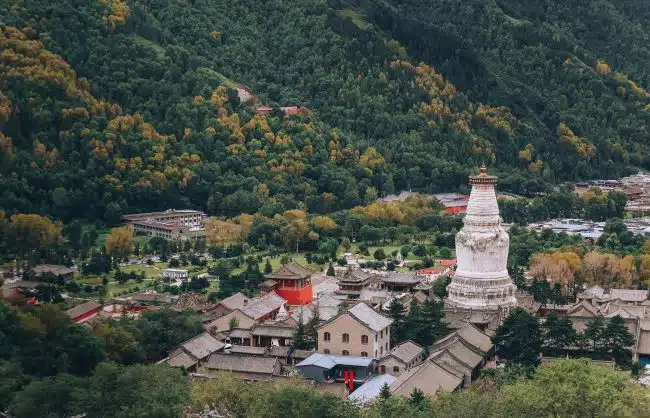
Mysterious and Sacred Buddhist Mountain
Another beautiful mountain in China, the beauty of Mount Wutai lies in both natural landscape and Buddhist importance. Located in Shanxi Province, Mount Wutai is regarded as one of the Four Sacred Mountains of Chinese Buddhism. Its five main peaks, 2000 to 3000 above sea level, are considered sacred and are associated with different bodhisattvas.
In June 2009, Wutai Mountain was inscribed on the World Heritage List.
Ancient Temples and Monasteries
Wutai Mountain is the Buddhist dojo in China where green temples (monk temple) and yellow temples (lamasery) coexist. There are 86 places of religious activities, and emperors of many dynasties came to pay their respects. Famous temples include: Hiantong Temple, Tayuan Temple, Pursat Deng, Nanshan Temple, Daili Deng, Jingge Temple, Wanfoge, and Bishan Temple.
Spiritual Retreat and Pilgrimage Destination
Anyone who makes a pilgrimage to Wutai Mountain has to worship at the five important temples. The Pagoda Temple houses a stupa built by King Ashoka of India, which is why Buddhists visit Wutai Mountain first and foremost to pay homage to this holy relic.
Recommended Tour: 5 Days Shanxi Highlights Tour: Pingyao, Wutai Mountain & Datong
10. Mount Gongga – King of Mountains in Sichuan
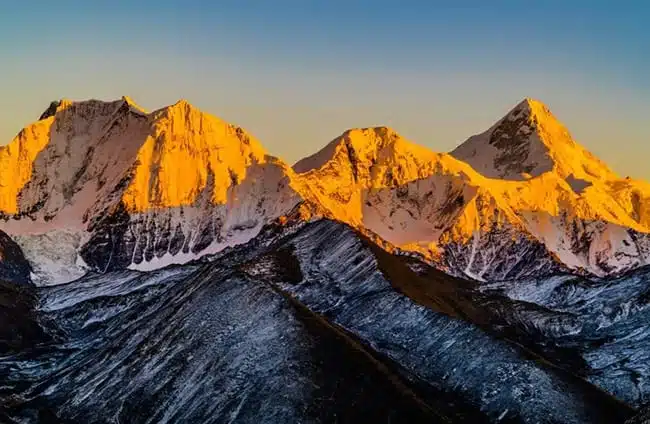
Majestic Snow-capped Peaks
Mount Gongga, also known as Minya Konka, is also one of the most beautiful mountains in China. In Tibetan, “gong” is the meaning of ice and snow, “ga” for white, so gongga means white iceberg. The main peak of Gongga Mountain, at 7,508.9 metres (2023 published data), stands majestically the highest mountain in Sichuan Province, surrounded by 45 peaks over 6,000 metres above sea level. It is also one of the mountains with the greatest height difference in the world.
Glaciers, Plateau Lakes, and Hot Springs
With glaciers such as Hailuogou, Bawang, Yanzigou and Muzigou and plateau lakes such as Mugetso, Wushuhai and Bawanghai, as well as hot springs such as Kangding Erdaoqiao, the Gongga Mountains are one of the world’s 25 hotspots for biodiversity.
Treks and Mountaineering Adventures
Mount Gongga offers thrilling opportunities for treks and mountaineering adventures. In 1932, Americans Terris Moore and Richard Burdsall made the first ascent of Gunga Mountain.
From moderate hikes through picturesque Hailuogou valleys to challenging ascents for experienced climbers, Gongga mountain attracts outdoor enthusiasts seeking both natural beauty and extreme activities.
More Information about the 10 Most Beautiful Mountains in China
| Mount Everest | World Heritage Site | May–October (dry season) | Himalayan orogeny formed the pyramid-shaped peak; glacial erosion created “pyramid valley”. 【Flag Cloud Phenomenon】Weather prediction based on ice wind and convection currents. |
Microbial oasis discovered at 6,500 meters; extremophiles thrive in extreme environments. |
| Mount Huangshan | Natural Wonder | March–May, Sept.–Nov. | Granite landform “Four Wonders”: peculiar peaks, ancient pines, sea of clouds, hot springs. 【Danxia Misconception】Huangshan isn’t typical Danxia landform—red sandstone is localized. |
Welcoming Pine undergoes annual health checks; lightning protection system costs over ¥1 million. |
| Mount Kailash | Sacred Mountain | April–June, Sept.–Nov. | Granite peak shaped by glacial erosion resembles a perfect pyramid; revered as the “Center of the Universe” in Hinduism/Buddhism. 【Magnetic Anomaly】Compasses often malfunction nearby. |
Annual cleanup removes 8 tons of trash from pilgrimage routes; foxes steal food from devotees. |
| Zhangjiajie Mountains | Natural Wonder | April–Oct. | Quartz sandstone peak forest resists weathering; “floating mountains” inspired Avatar. 【Suspension Bridge Principle】Built leveraging sandstone’s hardness. |
Sandstone contains pores; mistakenly identified as volcanic rock in early studies; Jinbian Creek water is potable. |
| Mount Hua | Extreme Challenge | June–Aug. (summer) | Granite fault cliffs form “the only path to Huashan”; plank walkway boards spaced 30 cm apart. 【Seismic Relic】Ming Dynasty earthquake created “Eagle Spreading Wings” trail. |
Maintenance requires manual transport of 20 kg wooden boards per person; North Peak view shows Yellow River like a silver thread. |
| Jade Dragon Snow Mountain | Natural Wonder | April–June, Sept.–Nov. | Glacial erosion formed U-shaped valley; modern glacier tongues descend to 2,700m elevation. 【Glacier Retreat Crisis】Lost 180m (1982–2020) at 5m/year. |
Vertical vegetation belts (2,000–4,500m); snow leopards critically endangered. |
| Mount Siguniang | Alpine Wonderland | June–Sept. | Granite peaks (Siguniang “Four Sisters”) dominate alpine valleys; moraine lakes reflect turquoise hues. 【Biodiversity Hotspot】Golden monkeys, Tibetan antelopes inhabit slopes. |
Alpine meadows bloom with gentians; Yala Glacier preserves ancient ice. |
| Mount Tai | Cultural Sacred Mountain | Feb.–March, Oct.–Nov. | 2.5 billion-year-old granite pluton uplifted by tectonic forces; “Sunrise from Heaven” ritual unchanged for millennia. 【Yin-Yang Boundary】Climate divide at Riguang Peak. |
3,000+ ancient cypresses; “Five Doctor Pine” sheltered Qin Shi Huang during historic ritual. |
| Mount Wutai | Buddhist Holy Mountain | May–June, Sept.–Oct. | Five flat-topped peaks symbolize Buddhist virtues; 1,000-year-old wooden monasteries cling to cliffs. 【Avalanche Control】Ancient stone walls stabilize slopes. |
Endemic cold-resistant plants thrive at 3,000m; cloud forests filter precipitation. |
| Mount Gongga | Hydrological Marvel | June–Sept. | Karakoram-Himalaya collision uplifted 7,556m peak; 1080m-high Hailuogou icefall feeds Yangtze tributaries. 【Permafrost Layers】Active layer thaws annually, revealing unique microorganisms. |
South China Karst Peaks and Rainbow Mountains in China
Beyond the top 10 beautiful mountains in China, the Karst mountains in Guilin and rainbow mountains in Zhangye are also world-famous and incredible choices a mountain adventure.
Guilin Mountains
It’s like you are traveling to an alien planet – the other-worldly karst peaks stretching across the small city with the picturesque Li River running through. Part of the South China Karst World Natural Heritage Site, Guilin’s karst mountains cover an area of 2,665 square kilometres. There are also caves and underground rivers. The so-called “Guilin’s landscape is the best in the world” is true to its name.
The most famous mountain peaks in Guilin include Elephant Trunk Hill, Folded Brocade Hill, Xianggong Hill, And Cuiping Hill.
Recommend: 5 Days Guilin, Yangshuo and Terrace Field Photography Tour
Zhengye Rainbow Mountains
The Zhangye Danxia Landforms, dating from the Pre-Jurassic to Tertiary Periods about 200 million years ago, is one of the richest landforms in China. Covering an area of more than 510 square kilometres, it has a peculiar shape with isolated peaks and steep rocks, and it is so colourful, therefore it is called the Rainbow Mountains of China.
Recommend: 3 Days Zhangye Essence Tour to Rainbow Mountain
To know more natural wonders of China, please read Fanjing Mounain and The 15 Most Beautiful Places in China









